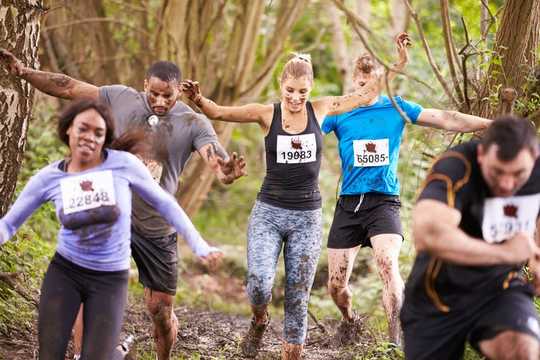
Finding a fitness routine that fits your life and then sticking to it is key. (Shutterstock)
Many of us, aware of the benefits of exercise, try to stick to a routine, only to find our sneakers at the back of the closet when the weather doesn’t co-operate, our routine is disrupted or we are short of time.
One way to turn an exercise fling into a long-term commitment is to develop an exercise identity. An exercise identity is what we imagine when we think of an “exerciser.” For most, this is someone who goes to the gym regularly or prioritizes their walk despite a busy schedule.
When we adopt an exercise identity, physical activity becomes a part of who we are and a powerful standard that can drive behaviour.
Research I conducted at the University of Manitoba and the University of Ottawa shows that the more adults identify with exercise or physical activity, the more they do it.
Other researchers agree with the power of exercise identity and have described it as one of the largest psychological correlates of exercise.
Walk the walk
So how does an exercise identity help people develop an exercise habit?
Exercisers feel uncomfortable when they don’t play the part and this discomfort can be motivating. Our research showed that people with a strong exercise identity who imagined not exercising for three weeks felt worse (more guilty), intended to get their exercise back on track and had more plans about how they would do this than people with a weaker exercise identity.

Something as simple as walking the dog can help you identify as an exerciser. (Shutterstock)
Identifying with exercise gives people an advantage. People with a strong exercise identity have plentiful and strong exercise plans and intentions. Their motivation to exercise also comes from quality sources — such as enjoyment or their values, rather than from guilt or pressure from others.
Exercise confidence is also strong among people with a solid exercise identity and all these things help people get moving.
Imagine yourself as fit
If you want to exercise more, start viewing yourself as an exerciser. But if your routine looks more like a Netflix marathon than true participation, you may be skeptical about how you are going to convince yourself that you are an exerciser.
Imagining yourself as one may help. Retirees who saw themselves in the future as a physically active person reported a stronger physical activity identity one month later.
In a follow-up study, retirees were instructed to imagine themselves as a physically active person which led to increases in physical activity identity four, eight and 12 weeks later.
However, because similar increases in identity were found among control participants, completing physical activity and identity measures may have been all it took to generate small increases in exercise identity.
Fake it until you make it
Even if you have a vivid imagination, you may need some behavioural proof that you are an exerciser. Fake it until you make it — simply start working out.
Inactive women increased their exercise identity after participating in 16 weeks of exercise. The identity increases occurred independent of how intensely or long the women exercised.

Exercising together helps. (Shutterstock)
This means that you don’t have to run 30 miles a week or break into a sweat to wear your exerciser badge. Some report that walking the dog or simply working physical activity into their daily lives (for example, get off the bus a few stops early) allows them to view themselves as an exerciser.
Regardless of the exact exercise routine that allows you to call yourself an exerciser, consistency is key. The take home: find a fitness routine that fits your life and then stick to it.
Exercise in a group
Though walking the walk is a way to convince yourself that you are an exerciser, becoming one is actually about more than just exercise.
In my research, people started seeing themselves as exercisers when physical activity crept into other aspects of their lives. So shamelessly wear the gear, even when you aren’t exercising. And don’t be shy to work exercise into your conversations.
Working out in a group has also been shown build identity and promote behaviour so add other exercisers within your social circle. These efforts may feel contrived but they often happen naturally when you put yourself out there in exercise contexts.
Shakespeare told us ages ago, in Hamlet that “thinking makes it so.” So play the part of exerciser and start thinking about the exerciser that you can be and are becoming.![]()
About The Author
Shaelyn Strachan, Associate Professor, University of Manitoba
This article is republished from The Conversation under a Creative Commons license. Read the original article.

Books Improving Attitude and Behavior from Amazon's Best Sellers list
"Atomic Habits: An Easy & Proven Way to Build Good Habits & Break Bad Ones"
by James Clear
In this book, James Clear presents a comprehensive guide to building good habits and breaking bad ones. The book includes practical advice and strategies for creating lasting behavior change, based on the latest research in psychology and neuroscience.
Click for more info or to order
"Unf*ck Your Brain: Using Science to Get Over Anxiety, Depression, Anger, Freak-Outs, and Triggers"
by Faith G. Harper, PhD, LPC-S, ACS, ACN
In this book, Dr. Faith Harper offers a guide to understanding and managing common emotional and behavioral issues, including anxiety, depression, and anger. The book includes information on the science behind these issues, as well as practical advice and exercises for coping and healing.
Click for more info or to order
"The Power of Habit: Why We Do What We Do in Life and Business"
by Charles Duhigg
In this book, Charles Duhigg explores the science of habit formation and how habits impact our lives, both personally and professionally. The book includes stories of individuals and organizations who have successfully changed their habits, as well as practical advice for creating lasting behavior change.
Click for more info or to order
"Tiny Habits: The Small Changes That Change Everything"
by BJ Fogg
In this book, BJ Fogg presents a guide to creating lasting behavior change through small, incremental habits. The book includes practical advice and strategies for identifying and implementing tiny habits that can lead to big changes over time.
Click for more info or to order
"The 5 AM Club: Own Your Morning, Elevate Your Life"
by Robin Sharma
In this book, Robin Sharma presents a guide to maximizing your productivity and potential by starting your day early. The book includes practical advice and strategies for creating a morning routine that supports your goals and values, as well as inspiring stories of individuals who have transformed their lives through early rising.
























